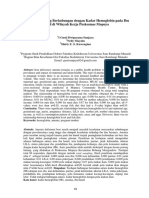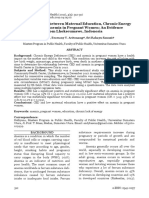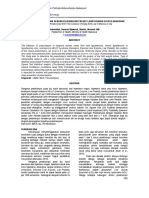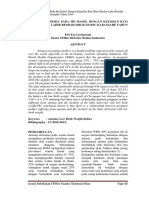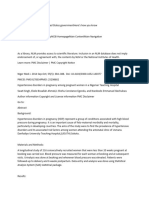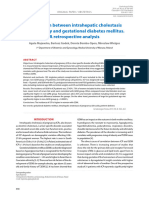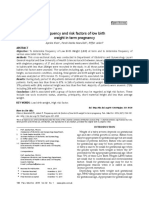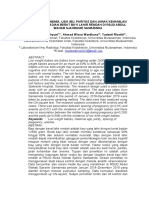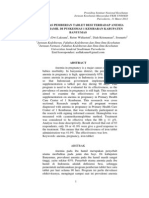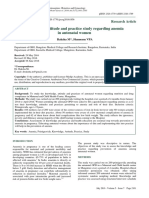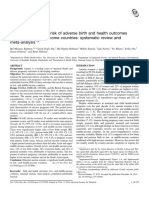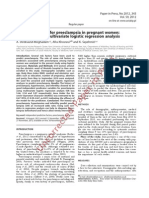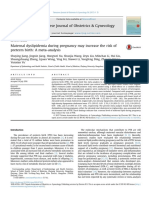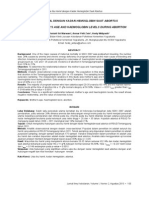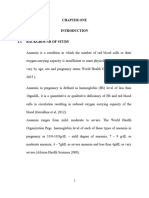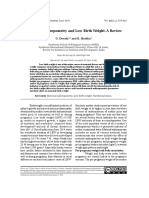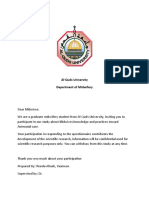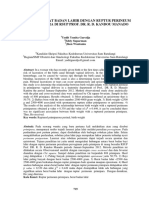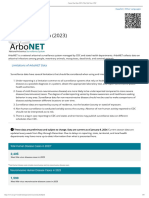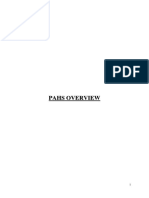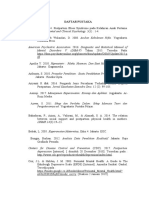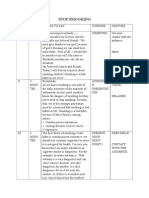Effect of Maternal Anaemia On Birth Weight: Original Article
Effect of Maternal Anaemia On Birth Weight: Original Article
Uploaded by
Tsulasatul HafidhohOriginal Description:
Original Title
Copyright
Available Formats
Share this document
Did you find this document useful?
Is this content inappropriate?
Report this DocumentCopyright:
Available Formats
Effect of Maternal Anaemia On Birth Weight: Original Article
Effect of Maternal Anaemia On Birth Weight: Original Article
Uploaded by
Tsulasatul HafidhohCopyright:
Available Formats
J Ayub Med Coll Abbottabad 2011;23(1)
ORIGINAL ARTICLE
EFFECT OF MATERNAL ANAEMIA ON BIRTH WEIGHT
Muhammad Owais Ahmad, Umay Kalsoom*, Ume Sughra*, Usman Hadi**,
Muhammad Imran
Departments of Physiology, *Community Medicine, Foundation University Medical College, Rawalpindi, **Health Services Academy,
Islamabad, Fauji Foundation Hospital, Rawalpindi
Background: Anaemia is a common medical problem in pregnancy. The extent up to which,
maternal anaemia effects maternal and neonatal health is still uncertain. Maternal anaemia is
commonly considered a risk factor for low birth weight (LBW) babies. Some studies have
demonstrated a strong association between low haemoglobin before delivery and LBW babies.
However, others have not found a significant association. Therefore, there is insufficient information
to assess the overall adverse impact of anaemia during pregnancy. The aim of this study was to
determine whether maternal anaemia would affect the birth weight of the baby and compare this with
that of non-anaemic mothers. It was a cross-sectional comparative study carried out at the maternity
ward of Fauji Foundation Hospital, Rawalpindi. Methods: One hundred subjects divided into two
groups each containing 50 subjects on the basis of consecutive non probability sampling were
included in the study. Group-A included 50 Anaemic pregnant women and Group-B 50 non-anaemic
pregnant women. Information was collected by direct interviewing method through a precoded
structured questionnaire. The Hb level and birth weights were taken from the labour room record.
Results: The mean age of the mothers in anaemic group was found to be older than the non anaemic
group, i.e., (29.44 versus 27.98), though the difference was statistically non significant. The number
of low birth weight infants (64%) was statistically very highly significantly more (p<0.001) in the
anaemic group of mothers than the non anaemic group (10%). Conclusion: The results of this study
show an association of maternal anaemia in pregnancy with increased risk of LBW babies.
Keywords: Maternal anaemia, Perinatal outcome, Low birth weight.
INTRODUCTION
Anaemia in pregnancy is a common problem and 50%
pregnant women in developing countries are suffering
from anaemia; 20% of the maternal deaths are directly or
indirectly related to anaemia. According to WHO criteria
Haemoglobin concentration of less than 11 gm/dl and
haematocrit of <033 is declared as anaemia in
pregnancy.1 Anaemia is a critical health concern because
it effects growth and development of neonates.
Prevalence of anaemia in developing countries is 56%, it
is even higher in the Central Asia, reported as being 80%
in India.2 Anaemia causes maternal morbidity and
mortality, and also affects the perinatal outcome, it can
also cause maternal infections, post partum haemorrhage
and pre-eclampsia. Pregnant anaemic mothers often
complain of body aches and easy fatigability.
In Pakistan common causes of anaemia are
poor economic conditions, illiteracy, lack of health
seeking behaviour, repeated pregnancies, gender bias and
worm infestation. Previous studies in Pakistan shows
iron deficiency as the main factor responsible for
anaemia in pregnancy.3 Anaemia is a common problem
in pregnant women especially in developing countries
like Pakistan, ranging from 8% to 33%, and increases the
risk of LBW and IUGR.4
Low birth weight is a major determinant of
mortality, morbidity and disability in infancy and
childhood and has a long term impact on health
outcomes in adult life.
Across the world, neonatal mortality is 20 times
more likely for low birth weight (LBW) babies
compared to heavier babies (2.5 kg).5 It is also
established as an important risk factor for neonatal
morbidity.6,7 The cohort of LBW (birth weight <2.5 Kg)
babies is likely to reflect two effects, namely a short
gestational age (preterm births) and small for gestational
age (SGA).
A strong relationship was found between
maternal anaemia and low birth weight babies.8 The
findings were in agreement with other studies of
anaemic pregnant women carried out in Pakistan9 and
Syria10. Women can develop iron deficiency anaemia
from the loss of blood during menstruation and from
repeated pregnancies; it can also be caused by a lack of
iron in the diet. During pregnancy, women may develop
anaemia because the growing foetus may draw upon the
mothers iron for the development of RBCs and other
tissues.11
There is variation in the data from different
studies about the association of maternal anaemia on
adverse pregnancy outcomes and there is insufficient
information to asses the overall adverse impact of
anaemia during pregnancy. The aim of the study was to
determine whether maternal anaemia would affect the
birth weight of the baby and compare this with that of
non-anaemic mothers.
http://www.ayubmed.edu.pk/JAMC/23-1/Owais.pdf
77
J Ayub Med Coll Abbottabad 2011;23(1)
MATERIALS AND METHODS
This was a comparative cross-sectional study,
comparing the effect of maternal anaemia on birth
weight of the baby with that of non-anaemic mothers.
This study took place at the Maternity ward of Fauji
Foundation Hospital, Rawalpindi and was carried out
from May 2009 to October 2009. Sample size was 100
divided into two groups each containing 50 subjects.
Group-A included 50 anaemic pregnant women and
Group-B 50 non-anaemic pregnant women. Sampling
technique was consecutive non-probability. Inclusion
criteria was all pregnant women 16 years and older and
a singleton pregnancy with a complete medical record.
In Group A pregnant women having haemoglobin levels
<11 g/dl in labour and in Group-B pregnant women
having haemoglobin levels 11 g/dl in labour were
included in this study. All women with a past history of
preterm delivery, obstetrical complications or any
medical illness, except anaemia, were excluded from the
study in order to control for the confounding factors. As
preterm delivery can recur in the next pregnancy, a past
history of preterm delivery can cause preterm delivery,
rather than anaemia.
The questionnaire for this study consists of
demographic and socioeconomic profile, education
level, antenatal history, obstetric history and birth
weights of the babies.
Information was collected by direct
interviewing method through a pre-coded structured
questionnaire. Every subject was approached personally,
briefed about the purpose of study, taken into
confidence and reassured about the confidentiality of
their information. Verbal informed consent was taken
before the start of study, each question was explained in
Urdu or in the language they understood and
questionnaire was filled on the spot so as to get unbiased
remarks. The Hb level and birth weights were taken
from the labour room record.
Data was analysed using SPSS-12. Descriptive
statistics were used to calculate means and standard
deviations for numerical data. These were compared
using t-test at a confidence level of 95%. Frequencies
were calculated for categorical data. These were
compared using 2 test, and p<0.05 was statistically
significant.
RESULTS
The results are summarised in Figure-1 and Table-1.
Figure-1 shows simple bar chart of the anaemic and nonanaemic mothers in different ages. When the ages of the
mothers in both the groups were compared, the mean age
of the anaemic group was found to be older than the nonanaemic group, (29.44 versus 27.98). However, the
difference between the two groups was statistically nonsignificant (p=0.146). The age for the anaemic mothers
78
ranged between 18 and 38 years, and age of non-anaemic
mothers ranged between 20 and 40 years.
Table-1 shows that whether the infant had low
birth weight at birth in anaemic and non anaemic
mothers. The difference between the two groups was
found to be statistically very highly significant
(p<0.001) in our study, as 64% of mothers delivered a
low birth weight baby in the anaemic group as against
10% in the non anaemic group.
30
25
20
15
10
A, Anemic
Group
B, Non-Anemic
Figure-1: Mean ages of the mothers in anaemic
and non-anaemic groups
Table-1: Low and normal birth weight babies of
the anaemic and non-anaemic mothers
Group
A: Anaemic (n=50)
B: Non-Anaemic (n=50)
p-Value
Underweight
Normal
32 (64%)
18 (36%)
5 (10%)
45 (90%)
0.001*
*Significant
DISCUSSION
Anaemia in pregnancy is an important public health
problem worldwide. WHO estimates that more than half
of pregnant women in the World have a haemoglobin
level indicative of anaemia (<11.0 g/dl), the prevalence
may however be as high as 56 to 61% in developing
countries.4
As it is estimated that about 7.3 million
perinatal deaths occur annually in the world, most of
these in developing countries especially Asia12, one
could assume many of these could be prevented by
correcting maternal anaemia. Prematurity and birth
anoxia are the main causes of perinatal deaths in
Pakistan. In the studied population, prematurity was the
leading cause of perinatal death but less frequent than in
other hospitals in Pakistan13, indicating poor
resuscitation facilities and neonatal care in the country.
Severe anaemia (<8 g/dl) is associated with birth weight
values that are 200400 g lower than in women with
higher (>10 g/dl) haemoglobin values, but these
researchers generally have not excluded other factors
that might also have contributed to both LBW and the
severity of anaemia.14
Low birth weight, i.e., <2.5 Kg is widely used
as an indicator of newborn health. The association of
LBW has been studied with a variety of factors relates
to geo-demographics, maternal health and pregnancy
http://www.ayubmed.edu.pk/JAMC/23-1/Owais.pdf
J Ayub Med Coll Abbottabad 2011;23(1)
history in various studies. Anaemia which is a common
problem in pregnant women in developing countries like
Pakistan increases the incidence of low birth weight.
Badshah et al15 in their study found that the
predicted incidence figures for low birth weight babies
show an increase among the Tribal areas of Pakistan in
anaemic mothers, with a highly significant difference
(p<0.01) in the incidence of low birth weight babies
among the anaemic mothers compared to non anaemic
mothers. Their study showed that anaemic mothers are
at increased risk of small for gestational age infants
compared to non anaemic mothers. The results of a
study in Ahmedabad, India by Mavalankar et al16, were
also consistent with Badshah et al15, with reference to
the effect of maternal anaemia on low birth weight.
Lone et al11 in a multivariate analysis of their
study population showed that the risk of low birth
weight babies in the anaemic population was 1.9 times
higher (95% CI= 1.03.4).
Jones et al17 also found an increased incidence
of low birth weight babies in anaemic mothers, however
the difference from the non anaemic group in their study
was non significant (p=0.11).
The results of our study were also consistent
with the above mentioned studies, showing that the
majority of anaemic mothers gave birth to low birth
weight babies, with a very highly significant difference
(p<0.001) from the non anaemic group.
The management and control of anaemia in
pregnancy is enhanced by the availability of local
prevalence statistics, which is however not adequately
provided in Pakistan.
CONCLUSION
The results show the association of maternal anaemia in
pregnancy with increased risk of LBW babies. Our
study also shows that anaemia in pregnancy is still a
major health problem. The improvements achieved in
the developed world may largely be due to more
effective diagnosis and treatment.
REFERENCES
1.
World Health Organization. The prevalence of anaemia in
women: a tabulation of available information. 2nd ed. Geneva:
World Health Organization; 1992.
2.
Harris ED. New insights into placental iron transport. Nutr Rev
1992;50:32931.
3.
Karim SA, Khurshid M, Memon AM, Jafarey SN. Anaemia in
pregnancy its cause in the underprivileged class of Karachi. J
Pak Med Assoc 1994;44:902.
4.
Badshah S, Mason L, McKelvie K, Payne R, Lisboa PJG. Risk
factors for low birth weight in the public-hospitals at Peshawar,
NWFP-Pakistan. BMC Public Health 2008;8:197.
5.
Ticconi C, Mapfumo M, Dorrucci M, Naha N, Tarira E,
Pietropolli A, et al. Effect of maternal HIV and malaria infection
on pregnancy and perinatal outcome in Zimbabwe. J Acquir
Immune Defic Syndr 2005;34:28994.
6.
Borja JB, Adair LS: Assessing the net effect of young maternal
age on birth weight. Am J Hum Biol 2003;15:73340.
7.
Valero De Bernab J, Soriano T, Albaladejo R, Juarranz M, Calle
ME, Martnez D, et al. Risk factors for low birth weight: a
review. Eur J Obstet Gynecol Reprod Biol 2004;116(1):315.
8.
Malhotra M, Sharma JB, Batra S, Sharma S, Murthy NS, Arora
R. Maternal and Perinatal outcome in varying degrees of
anaemia. Int J Gynecol Obstetr 2002;79:93100.
9.
Khan MM. Effect of maternal anaemia on fetal parameters. J
Ayub Med Coll Abbottabad 2001;13(2):3841.
10. Wannous S, Arous S. Incidence and determinants of low birth
weight in Syrian government hospitals. East Mediterr Health J
2001;7:96674.
11. Lone FW, Qureshi RN, Emanual F. Maternal anaemia and its
impact on perinatal outcome in a tertiary care hospital in
Pakistan. Trop Med Int Health 2004;4:4869.
12. Shazia T, Faheem S, Saad R. Perinatal mortality: a survey. Paki J
Obstet Gynecol 1994;7(2):18.
13. Rana S. Coordinated maternity services. Pak J Obstet Gynecol
1994;7(1):119.
14. Steer P, Alam MA, Wadsworth J, Welch A. Relationship
between maternal hemoglobin concentration and birth weight in
different ethnic groups. BMJ 1995;310:48991.
15. Badshah S, Mason L, Mckelvie K, Payne R, Lisboa PJ. Risk
factors for low birth weight in the public hospitals at Peshawar,
NWFP-Pakistan. BMC Public Health 2008;8:197206.
16. Mavalankar DV, Gray RH, Trivedi CR. Risk factors for preterm
and term low birth weight in Ahmedabad, India. Int J Epidemiol
1992;21:26372.
17. Jones DW, Weiss HA, Changalucha JM, Todd J, Gumodoka B,
Bulmer J, et al. Adverse birth outcomes in United Republic of
Tanzania Impact and prevention of maternal risk factors. Bull
World Health Organ 2007;85:918.
Address for Correspondence:
Dr. Muhammad Owais Ahmad, Associate Professor of Physiology, Kabir Medical College, Canal Road,
University Town Peshawar, Pakistan. Cell: +92-300-5172892
Email: drmowais@hotmail.com
http://www.ayubmed.edu.pk/JAMC/23-1/Owais.pdf
79
You might also like
- Arthur Kleinman The Illness Narratives Suffering Healing and The Human ConditionDocument46 pagesArthur Kleinman The Illness Narratives Suffering Healing and The Human Conditionperdidalma57% (14)
- Assignment - Medicines Development Process and Good Clinical PracticeDocument2 pagesAssignment - Medicines Development Process and Good Clinical PracticeZornicaBorisovaNo ratings yet
- CHN Lessonplan (NRHM - National Rural Health Mission)Document23 pagesCHN Lessonplan (NRHM - National Rural Health Mission)Samjhana Neupane100% (6)
- Schistosomiasis Control ProgramDocument2 pagesSchistosomiasis Control ProgramKrizle AdazaNo ratings yet
- C0141240911 PDFDocument3 pagesC0141240911 PDFTopan AzzuriniNo ratings yet
- Tugas Inggris 3 Session 2Document221 pagesTugas Inggris 3 Session 2dinaNo ratings yet
- Faktor Faktor Yang Berhubungan Dengan Kadar Hemoglobin Pada Ibu Hamil Di Wilayah Kerja Puskesmas MopuyaDocument14 pagesFaktor Faktor Yang Berhubungan Dengan Kadar Hemoglobin Pada Ibu Hamil Di Wilayah Kerja Puskesmas MopuyaIsmaji IsmajiNo ratings yet
- The Associations Between Maternal Education, Chronic Energy Deficit, and Anemia in Pregnant Women: An Evidence From Lhokseumawe, IndonesiaDocument5 pagesThe Associations Between Maternal Education, Chronic Energy Deficit, and Anemia in Pregnant Women: An Evidence From Lhokseumawe, IndonesiaElin Kania AudiyawatiNo ratings yet
- 6 UN Reddy EtalDocument6 pages6 UN Reddy EtaleditorijmrhsNo ratings yet
- Pharmaceutical Sciences: Anemia in Pregnancy A Cause of Low Neonatal Birth WeightDocument4 pagesPharmaceutical Sciences: Anemia in Pregnancy A Cause of Low Neonatal Birth WeightiajpsNo ratings yet
- Pattern of Glucose Intolerance Among Pregnant Women With Unexplained IUFDDocument5 pagesPattern of Glucose Intolerance Among Pregnant Women With Unexplained IUFDTri UtomoNo ratings yet
- Determinants of PreDocument9 pagesDeterminants of PreAr OnaNo ratings yet
- Jurnal BBLRDocument5 pagesJurnal BBLRDeandira ThereciaNo ratings yet
- Chapter 3Document32 pagesChapter 3Vaibhav JainNo ratings yet
- Prevalence and Possible Risk Factors of Anaemia in Different Trimesters of Pregnancy PDFDocument4 pagesPrevalence and Possible Risk Factors of Anaemia in Different Trimesters of Pregnancy PDFMarlon SoselisaNo ratings yet
- Faktor-Faktor Yang Mempengaruhi Kejadian Bayi Berat Lahir Rendah Pada Ibu Melahirkan Di Ruang Perinatologi Rumah Sakit Umum Daerah 45 Kuningan Dian WidianingsihDocument4 pagesFaktor-Faktor Yang Mempengaruhi Kejadian Bayi Berat Lahir Rendah Pada Ibu Melahirkan Di Ruang Perinatologi Rumah Sakit Umum Daerah 45 Kuningan Dian WidianingsihOqiSaefullohNo ratings yet
- Abed,+1114 Impacts+of+Dietary+Supplements+and+Nutrient Rich+Food+for+Pregnant+Women+on+Birth+Weight+in+Sugh+El Chmis Alkhoms+-+LiDocument8 pagesAbed,+1114 Impacts+of+Dietary+Supplements+and+Nutrient Rich+Food+for+Pregnant+Women+on+Birth+Weight+in+Sugh+El Chmis Alkhoms+-+LiLydia LuciusNo ratings yet
- Linda Anisa - Pemeriksaan HBDocument4 pagesLinda Anisa - Pemeriksaan HBP17312215223 LINDA ANISANo ratings yet
- Hubungan Anemia Pada Ibu Hamil Dengan Ke PDFDocument8 pagesHubungan Anemia Pada Ibu Hamil Dengan Ke PDFGloria KarinaNo ratings yet
- 1 s2.0 S111056901400034X MainDocument5 pages1 s2.0 S111056901400034X Mainade lydia br.siregarNo ratings yet
- Low Birth Weight InfantsDocument5 pagesLow Birth Weight Infantserine5995No ratings yet
- Hypertension in PregnancyDocument11 pagesHypertension in Pregnancyadughjacob3No ratings yet
- Presenter DR - Sachin Shekde (Assistant DHO) Guide DR - Yogesh ManeDocument37 pagesPresenter DR - Sachin Shekde (Assistant DHO) Guide DR - Yogesh Maneymane7461No ratings yet
- Perinatal - Outcome - in - Oligohydramnios SynopsisDocument16 pagesPerinatal - Outcome - in - Oligohydramnios SynopsisdhanrajramotraNo ratings yet
- Association Between Intrahepatic Cholestasis in Pregnancy and Gestational Diabetes Mellitus. A Retrospective AnalysisDocument6 pagesAssociation Between Intrahepatic Cholestasis in Pregnancy and Gestational Diabetes Mellitus. A Retrospective AnalysisDr.Karima EldarhobiNo ratings yet
- Vol93 No.6 661 5058Document6 pagesVol93 No.6 661 5058Titi Afrida SariNo ratings yet
- File Kohort RR Ibu HamilDocument10 pagesFile Kohort RR Ibu Hamilchindysilvia128No ratings yet
- Maternal and Perinatal Outcome of Gestational Diabetes Mellitus in Persahabatan General HospitalDocument11 pagesMaternal and Perinatal Outcome of Gestational Diabetes Mellitus in Persahabatan General HospitalCindy AgustinNo ratings yet
- Anupama Sharma, Et AlDocument10 pagesAnupama Sharma, Et AlAGERI PUSHPALATHANo ratings yet
- Khan, Et Al. (2016) - Frequency and Risk Factors of Low Birth Weight in Term Pregnancy. Pakistan Journal of Medical Science, 32 (1), Pp. 138-142.Document5 pagesKhan, Et Al. (2016) - Frequency and Risk Factors of Low Birth Weight in Term Pregnancy. Pakistan Journal of Medical Science, 32 (1), Pp. 138-142.Adib FraNo ratings yet
- The Role of Husband in Assisting Wife Who Suffer Anemia in PregnancyDocument8 pagesThe Role of Husband in Assisting Wife Who Suffer Anemia in Pregnancyyudistira chairinaNo ratings yet
- Pre-Existing Diabetes Mellitus and Adverse PDFDocument5 pagesPre-Existing Diabetes Mellitus and Adverse PDFMetebNo ratings yet
- Muest RaDocument13 pagesMuest RaBruno LinoNo ratings yet
- OGTT and Adverse Outcome 2020Document10 pagesOGTT and Adverse Outcome 2020Nuraida baharuddinNo ratings yet
- Manuskrip Winda Trie Wahyuni - 1610015045Document10 pagesManuskrip Winda Trie Wahyuni - 1610015045Scribd proNo ratings yet
- Jurnal AnemiaDocument8 pagesJurnal AnemiaNisa Rahmah F100% (1)
- Hypo Glyc RevDocument6 pagesHypo Glyc RevJoseNaranjoValenciaNo ratings yet
- Knowledge, Attitude and Practice Study Regarding Anemia in Antenatal WomenDocument3 pagesKnowledge, Attitude and Practice Study Regarding Anemia in Antenatal WomenanggiNo ratings yet
- Maternal Anemia and Risk of Adverse Birth and Health Outcomes in Low-And Middle-Income Countries: Systematic Review and Meta-AnalysisDocument10 pagesMaternal Anemia and Risk of Adverse Birth and Health Outcomes in Low-And Middle-Income Countries: Systematic Review and Meta-AnalysisCarlos GonzalesNo ratings yet
- CHAPTERSDocument22 pagesCHAPTERSArchana SahuNo ratings yet
- BHS InggrisDocument9 pagesBHS InggrisAies AishaNo ratings yet
- Factor Associated With LBW Among Newborn West EthiopiaDocument6 pagesFactor Associated With LBW Among Newborn West EthiopiaLydia LuciusNo ratings yet
- Predictive Factors For Preeclampsia in Pregnant Women: A Unvariate and Multivariate Logistic Regression AnalysisDocument5 pagesPredictive Factors For Preeclampsia in Pregnant Women: A Unvariate and Multivariate Logistic Regression AnalysisTiti Afrida SariNo ratings yet
- The Effect of Anemia Among Pregnant Women To Low Birth Weight Babies: A Meta-Analysis in Various Countries From 2015 To 2019Document15 pagesThe Effect of Anemia Among Pregnant Women To Low Birth Weight Babies: A Meta-Analysis in Various Countries From 2015 To 2019Riska YulistiaNo ratings yet
- Maximal Amniotic Fluid Index As A Prognostic Factor in Pregnancies Complicated by PolyhydramniosDocument6 pagesMaximal Amniotic Fluid Index As A Prognostic Factor in Pregnancies Complicated by PolyhydramniosNidiaPurwadiantiNo ratings yet
- 521 2345 1 PB Converted 1Document14 pages521 2345 1 PB Converted 1prabuNo ratings yet
- Copy-NUTRITIONAL ANAEMIADocument6 pagesCopy-NUTRITIONAL ANAEMIAKeasNo ratings yet
- Taiwanese Journal of Obstetrics & GynecologyDocument7 pagesTaiwanese Journal of Obstetrics & GynecologyHartanto LieNo ratings yet
- Jurnal - Usia Ibu Hamil Dengan Kadar Hemoglobin Saat AbortusDocument8 pagesJurnal - Usia Ibu Hamil Dengan Kadar Hemoglobin Saat AbortusChika Marsya Regizta CheremyNo ratings yet
- Impact of Preeclampsia and Gestational Hypertension On Birth Weight by Gestational AgeDocument7 pagesImpact of Preeclampsia and Gestational Hypertension On Birth Weight by Gestational AgegeraldersNo ratings yet
- 1 PB PDFDocument7 pages1 PB PDFAmanda Mustika AdiNo ratings yet
- The Correlation Between Hemoglobin Concentration During Pregnancy With The Maternal and Neonatal OutcomeDocument5 pagesThe Correlation Between Hemoglobin Concentration During Pregnancy With The Maternal and Neonatal OutcomeKhrisna AdjiNo ratings yet
- Sideropaenic Anaemia: Impact On Perinatal Outcome at Tertiary Care HospitalDocument5 pagesSideropaenic Anaemia: Impact On Perinatal Outcome at Tertiary Care HospitalNimas Ayu Lestari NNo ratings yet
- Jurnal BBLRDocument17 pagesJurnal BBLRSri YunitaNo ratings yet
- 33 82 5 PBDocument12 pages33 82 5 PBRendra SathaNo ratings yet
- Scientific Advisory Committee Opinion Paper 23: 1. BackgroundDocument5 pagesScientific Advisory Committee Opinion Paper 23: 1. BackgroundNatia DemetradzeNo ratings yet
- Anaemia ProjectDocument96 pagesAnaemia ProjectSALIHU ISAHNo ratings yet
- Anemia Among Antenatal Mother in Urban MalaysiaDocument6 pagesAnemia Among Antenatal Mother in Urban MalaysiaOmy NataliaNo ratings yet
- P ('t':'3', 'I':'668007329') D '' Var B Location Settimeout (Function ( If (Typeof Window - Iframe 'Undefined') ( B.href B.href ) ), 15000)Document5 pagesP ('t':'3', 'I':'668007329') D '' Var B Location Settimeout (Function ( If (Typeof Window - Iframe 'Undefined') ( B.href B.href ) ), 15000)niko4eyesNo ratings yet
- HHS Public Access: Folic Acid Supplementation and Dietary Folate Intake, and Risk of PreeclampsiaDocument15 pagesHHS Public Access: Folic Acid Supplementation and Dietary Folate Intake, and Risk of PreeclampsiaDevi KharismawatiNo ratings yet
- Maternal Anthropometry and Low Birth Weight: A Review: G. Devaki and R. ShobhaDocument6 pagesMaternal Anthropometry and Low Birth Weight: A Review: G. Devaki and R. ShobhaJihan PolpokeNo ratings yet
- Complementary and Alternative Medical Lab Testing Part 10: ObstetricsFrom EverandComplementary and Alternative Medical Lab Testing Part 10: ObstetricsNo ratings yet
- Complementary and Alternative Medical Lab Testing Part 9: GynecologyFrom EverandComplementary and Alternative Medical Lab Testing Part 9: GynecologyNo ratings yet
- A Detailed Lesson in Plan in MapehDocument7 pagesA Detailed Lesson in Plan in MapehVia Thriss Ann SalasNo ratings yet
- 15-17 - 7-PDF - Community Medicine With Recent Advances - 3 PDFDocument3 pages15-17 - 7-PDF - Community Medicine With Recent Advances - 3 PDFdwimahesaputraNo ratings yet
- Blueprint Obgyn - Google PenelusuranDocument1 pageBlueprint Obgyn - Google PenelusuranNilam Siti RahmahNo ratings yet
- Al-Quds University Department of MidwiferyDocument7 pagesAl-Quds University Department of MidwiferyMALIK MANASRAHNo ratings yet
- Standard Precaution: Prof. Dr. Ida Parwati, PHDDocument23 pagesStandard Precaution: Prof. Dr. Ida Parwati, PHDPutri Senna Rahayu100% (2)
- Centers For Disease Control and Prevention - Official Organizational Chart - Updated 7 - 5 - 2022Document1 pageCenters For Disease Control and Prevention - Official Organizational Chart - Updated 7 - 5 - 2022zahraa aliNo ratings yet
- World Health OrganizationDocument13 pagesWorld Health OrganizationVincent Ranara Sabornido100% (1)
- Hubungan Berat Badan Lahir Dengan Ruptur Perineum Pada Primipara Di Rsup Prof. Dr. R. D. Kandou ManadoDocument7 pagesHubungan Berat Badan Lahir Dengan Ruptur Perineum Pada Primipara Di Rsup Prof. Dr. R. D. Kandou ManadoErianti VioletaNo ratings yet
- Policy On Needle StickDocument2 pagesPolicy On Needle StickRemy TevesNo ratings yet
- Standard Precaution HandoutDocument3 pagesStandard Precaution Handoutaringkinking100% (1)
- Children's Community Mental Health Services (CCMHS) BrochureDocument2 pagesChildren's Community Mental Health Services (CCMHS) BrochureChild and Family InstituteNo ratings yet
- Chapter 4.2 Maternal Care and Services 2022Document61 pagesChapter 4.2 Maternal Care and Services 2022Nicole Sales DiazNo ratings yet
- Maruti Institute of Nursing, Itarsi: Maternal Nursing Child Health Nursing Medical Surgical Nursing Nursing FoundationDocument4 pagesMaruti Institute of Nursing, Itarsi: Maternal Nursing Child Health Nursing Medical Surgical Nursing Nursing FoundationHarshaNo ratings yet
- Presentation 5 The Infection Control Risk Assessment and PlanDocument24 pagesPresentation 5 The Infection Control Risk Assessment and PlanLany PasauNo ratings yet
- Evolution of Public HealthDocument51 pagesEvolution of Public HealthShruti MurthyNo ratings yet
- Current Year Data 2023 West Nile Virus CDCDocument30 pagesCurrent Year Data 2023 West Nile Virus CDCapi-720792255No ratings yet
- Morbili: Residen Pembimbing Dr. Maryam Kusumawati Supervisor Dr. Safruddin Amin, SP - KK (K), MARS., FINSDVDocument15 pagesMorbili: Residen Pembimbing Dr. Maryam Kusumawati Supervisor Dr. Safruddin Amin, SP - KK (K), MARS., FINSDVnabillaNo ratings yet
- Evaluation:: Basinang, Rica Kyrie T BSN 2 Community Health NursingDocument7 pagesEvaluation:: Basinang, Rica Kyrie T BSN 2 Community Health NursingloviNo ratings yet
- PAHS MBBS Curriculum PDFDocument224 pagesPAHS MBBS Curriculum PDFD r bharat yadavNo ratings yet
- Repetition Following Amelioration in Homoeopathy A Randomized Placebo Controlled Pilot StudyDocument7 pagesRepetition Following Amelioration in Homoeopathy A Randomized Placebo Controlled Pilot StudyHomoeopathic PulseNo ratings yet
- Designs of Clinical TrialDocument7 pagesDesigns of Clinical TrialSruthi100% (1)
- Interview SheetDocument3 pagesInterview SheetSheryhan Tahir BayleNo ratings yet
- Daftar PustakaDocument5 pagesDaftar PustakaFauzy ImamNo ratings yet
- Stop SmookingDocument3 pagesStop SmookingPrhameswati Cahyaning KinasihNo ratings yet
- Hiv Aids Surveillance Europe 2018 PDFDocument134 pagesHiv Aids Surveillance Europe 2018 PDFafbmgNo ratings yet
- Epidemiological SurveillanceDocument36 pagesEpidemiological SurveillanceNathnael GebeyehuNo ratings yet






